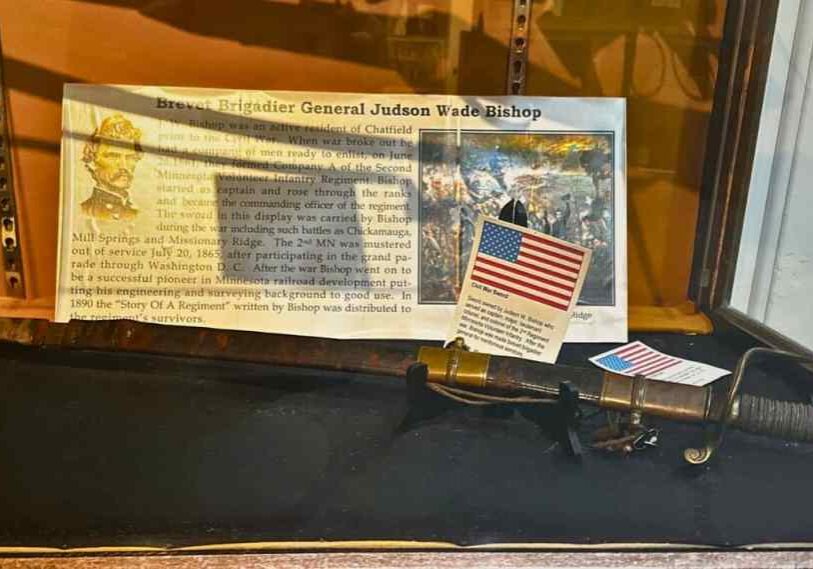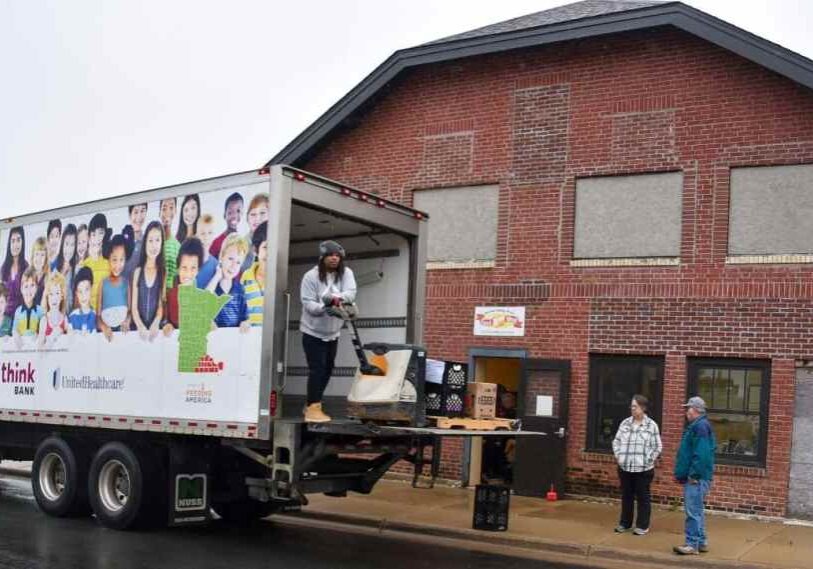Shooting Star Trail Was Once an Indigenous Crossroads
Hamline University archaeological team surveys sites in Southeast Minnesota

MOWER COUNTY – Bicyclists riding the paved Shooting Star State Trail between Austin and LeRoy are likely traveling the same route Indigenous people used hundreds, and even thousands, of years ago. In fact, all of Mower County was considered an important cultural crossroads long before Minnesota became a state.
In addition to researching numerous water and land trails, including what is now the Shooting Star State Trail, a team from the Hamline University Center for Anthropological Services (HUCAS) has found signs of a previously unknown village, and vast resources of an important type of stone used to make tools. These researchers are in the midst of an archaeological survey in Mower County to learn more about what life was like in the area before European-American settlers arrived.
The Mower County survey, which started in the spring of 2024 and wraps up in June 2025, is part of a statewide archaeological effort to survey every county in the state. The statewide survey started in 2010; it picked up where a previous survey in the 1970s and 1980s – which included Fillmore and Houston counties – left off. The survey’s goal is to increase the number of documented sites, improve geographic representation and update records of previously recorded sites.
The center is working with a variety of partners on the current survey, including Dakota communities, local residents, previous researchers and the Mower County Historical Society. The project is financed with funds provided by the State of Minnesota’s Arts and Cultural Heritage Fund through the Minnesota Historical Society.
Mower County has deposits of flint
One reason Mower County was chosen for the survey is because of its lack of archaeological knowledge, said archaeologist Dave Tennessen, principal investigator at HUCAS. However, Mower County also has some very exciting features that have drawn the researchers to the area.
Mower County is on the western edge of the Driftless Area, a pocket of land missed by glaciation that ended about 11,000 years ago. The lack of ice resulted in four watersheds starting in Mower County — the Cedar, Root, Upper Iowa and Wapsipinicon rivers — plenty of time for the main channels of the rivers to cut into the bedrock, eventually draining into the Mississippi River between La Crosse and Davenport.
“All of these river systems provide a connection between the cultures and people that were living in the Mississippi River valley, providing them with highways up into southeastern Minnesota and then ultimately, perhaps, further westward out onto the plains,” said Tennessen.

The historical trail, in the lower map (by Tom Trow and Adam Demers), aligns with the existing Shooting Star Trail, above. (Photo composite by Root River Current)
Another characteristic of the Driftless Area is that the bedrock is largely limestone and dolomite that contains many deposits of chert, sometimes called flint. This sedimentary rock is composed almost entirely of silica, which can be flaked to produce stone tools.
This valuable resource was easy to find in Mower County, particularly around Grand Meadow, because a layer of distinctive gray chert was very close to the surface. This attracted people who picked up the tool stone as they moved through the area on or along the river systems. (Read more about these chert discoveries in David Phillips’ article on the Grand Meadow-area Chert Quarry opening to the public in 2025.)
“What’s really interesting to us as archaeologists is that it’s often possible to trace different varieties of chert to source locations, so we can start getting a handle on the paths that people are taking, the ways they’re traveling as they move through the county and surrounding regions,” said Tennessen. “We can also trace some of these materials very long distances eastward and westward.”
Another characteristic is that Mower County, while partially wooded at the time, had tracts of open prairie and was a pathway to even larger expanses of prairie, which was a good location for hunting bison by people living in the wooded lands to the east. In earlier times, they may have hunted mastodon, or mammoth. Mastodon teeth have been found in Mower County, although there is no physical evidence of people hunting them.
Around 8,000 years ago, people tended to be nomadic, carrying all their possessions with them as they moved about, depending on where the best resources were located, noted team member Tom Sanders, an Indigenous archaeological specialist.
About 1,000 years ago, people were more likely to live in villages, Sanders said, but there was probably still quite a bit of activity outside their homes as different groups would get together for a bison hunt. Traders also made their way through the area looking for resources and some young adults traveled to look for partners since they wouldn’t have wanted to marry someone from their own village where nearly everyone was related.
Some of the earliest evidence in the county, based on distinctive tool types similar to artifacts at other sites, suggest the first people inhabited the area some 8,000 years ago, said Tennessen, although no sites in Mower County have been radiometrically dated, which gives a more exact measurement.
Hand-drawn map provides clues
The connection of the Indigenous trail to the Shooting Star didn’t come from archaeologists. Instead, the discovery stemmed from a hand-drawn 1837 map used by a delegation of Ioway who took it to Washington, D.C. to argue their case for possession of their lands, noted Tennessen. The map, which shows major rivers, trails and villages, was likely drawn from information collected from conversations with elders or memories of drawings in sand or dirt since the landscape had changed drastically for the Ioway people by 1837.

This 1837 map drawn by Ioway people shows their territory for a congressional committee. It was later georeferenced to a 2003 map, showing surprising accuracy. The original map identified a village near Austin that was unknown to archaeologists. (Photo by Tom Trow)
It wasn’t until 2003 that the map took on archaeological importance. It was then that a graduate student working on her doctorate’s thesis took the 1837 map and georeferenced it to a modern map with known geographic coordinates. The project showed the crude map to be remarkably accurate. One of the trails on the map aligns with the Shooting Star Trail.
“Indigenous trails turn into ox cart trails, which turn into railroad rights-of-ways, which turn into roads, and in some cases bike trails,” explained Tennessen.
The trail is parallel to a river, so it could have been an overland leg, getting people to different villages or to a larger part of the water highway so they could travel to the Mississippi River, speculated Tennessen.
Even more fascinating to the researchers, the 1837 map shows a village near Austin that archaeologists didn’t know existed. The map places the village along the Cedar River near an intersection with another segment of the Indigenous trail, a site that the researchers have started investigating.
Although there’s not much evidence yet, the team found some pottery shards below the ground at the site, which is “one of the things we’re excited about,” said Brian Hoffman, director of HUCAS, chair of the Anthropology Department at Hamline and associate professor of anthropology.
“That’s a good reason to expect that this is a place where people were spending more time and utilizing a wide range of the resources,” he said.
Survey, a low-tech operation
“Archaeological surveys tend to be very, very low tech,” said Tennessen. “We focus on two procedures, or two methods, when we look for sites. In areas where the fields have been recently plowed, where we have good ground visibility, we line up in a row and walk across the surface, watching where we’re walking, and look for artifacts on the surface.”

Hamline University students help survey a field during the Mower County survey, which began in 2024. (Photo by Tom Trow)
The other method used, although much less frequently because it is time-consuming, is shovel-testing, which is also ‘low-tech’. The team digs a 15- to 20-inch-wide hole, removes material straight down and screens the sediments as it comes out. If something of interest shows up, the workers investigate more thoroughly.
More than 90 percent of the land in Mower County is categorized as agricultural. The regular plowing of fields constantly turns up new material to investigate.
“On one hand, certainly that agricultural activity has disrupted and distorted the archaeological record. But at the same time, it opens up huge areas and allows us to survey it very efficiently,” said Tennessen.
If team members do find something on the surface of a plowed field, often they head over to a field edge or a nearby location that hasn’t been plowed and, if possible, do a subsurface investigation to see if they can find intact buried deposits.
Fragments can show insight
Much of what archaeologists often find are scatters of stone tools, which are preserved almost indefinitely, and debris from manufacturing stone tools on the surfaces of cultivated fields. The craftsperson who made the tools initiated a fracture through the stone, rather than pulverizing, so the flakes that came off have “rather distinctive morphologies” that may reflect the techniques used to produce the stone tools, Tennessen explained.

A spear point collected at a field near Adams. The entire collection will be unveiled during a presentation at the Adams Area Historical Society and History Center on June 7 at 2 p.m. during the community’s Dairy Days celebration. (Photo by Tom Trow)
“When we have lithic artifacts on the surface, at first blush they look kind of uninteresting,” Tennessen said, “but they provide a huge amount of information about the pathways, or the ways people have traveled, the other groups they may be in contact with, the way they produce their stone tools and, of course, that may differ from one group of people to another.”
Those findings are important as they provide useful details, but it is a limited range of information, so it is important to incorporate different types of knowledge with the archaeological record.
Other resources show bigger picture of ancient life
“If we want to start answering the questions like, ‘how do the things we find in the archaeological record relate to people living today,’ we need other sorts of information, too – things like oral tradition, cultural knowledge, traditional environmental knowledge, that sort of thing,” said Tennessen.
One of the ways they do that is through Tom Sanders, who worked for many years at Jeffers Petroglyphs, home to about 5,000 sacred rock carvings made by the ancestors of today’s Native Americans in southwestern Minnesota. He has consulted with elders on various projects for more than 30 years.
Sanders, who has Indigenous heritage, said he has established relationships with many elders who are involved in everything the team does in the surveys, adding their insight into the research since the findings reveal a part of their heritage.
“We’re in constant dialog with elders, particularly knowledgeable elders, who help us when we design what we’re going to do for the final report,” Sanders said. “Every step, they’re involved so there’s a very, very rich story we can tell in the end.”
He notes that it is a collaborative process with archaeologists providing important information that the elders can supplement with their own history about what life was like in the past.
“We’re colleagues working toward a greater good of trying to understand human beings,” he said.
Local landowners also important
“Because so much land is in private ownership in the county, we really have to be establishing a network of relationships with people across the county to gain access to property, but also, in many cases, the landowners have very deep knowledge of their property and have provided us with really important information,” said Tennessen.
Another member of the team, Tom Trow, who was the archaeological team leader for the 1979-80 survey in Fillmore and Houston counties and who has been working in Mower County on a different project involving Grand Meadow chert, has a lot of local connections He acts as “our land agent in a sense,” said Tennessen. He has established his own trustworthiness and credibility, which has helped the survey team, he added.

A scene from the Root River valley in 1979 when an archaeological survey was done in Fillmore and Houston counties. The watershed for the river begins in Mower County. (Photo by Tom Trow)
One of the important discoveries that helped the survey team was when a landowner near Adams brought in a collection of artifacts from the last century to the Adams Area Historical Society and History Center, which then contacted Trow.
“It’s a really good example of how these kinds of personal connections are essential to doing this kind of work. So, 100 years of collecting arrowheads from farm fields has definitely changed the composition of our archaeological assemblages when archaeologists come back 100 years later,” said Tennessen.
When landowners are willing to share collections, the survey team can combine that information with work it is doing in the field for a much more complete picture of what that site represents, he added.
Trow said the Adams collection is a huge, mounted collection of artifacts, such as spear points and projectile points, that someone’s grandfather or great grandfather had gathered in the early 1900s before most people had started collecting. All were from a tract of land along the Little Cedar River, important information for research because the exact location is known.
“It was this extraordinary look at the past that we don’t normally get,” said Trow.
The variety of artifacts represents thousands of years in time of people living on the land. Some of the stone is from hundreds of miles away, as far as North Dakota and Missouri, likely received through trade, he added, showing how actively people interacted with each other.
The Adams History Society is also proud of the find. A presentation of the collection will be shown to the public at the Adams History Center during the community’s Dairy Days on June 7 at 2 p.m.
Archaeology more than just research
“Archaeologists often talk about public archaeology, but I think what we’re trying to do is public archaeology writ large, so we’re bringing in people who potentially might visit a museum on a weekend,” said Tennessen, “but also people who collected artifacts, or arrowheads, in farm fields when they were growing up, farmers who own property today, descendent communities, the Dakota communities of Minnesota and so on. We’re really trying to cast a broad net and bring in as much information to bear as we can on what’s shaping up to be a really fascinating story.”
Hoffman concurred, saying that HUSCA is doing different types of work in addition to archaeological surveys, such as cemetery assessments and work with the state or tribes on cultural projects – the center emphasizes the “services” part of its name.
Often, it takes its lead from entities such as the Mower County Historical Society or the Native American communities it is working with.
“Even though some of what we do has a research component to it, our primary goal is to make what we do, of use or service to the communities we’re working with,” he said. “A lot of our purpose comes from the communities that we are working for.”
Once the survey is done, the team will be producing two reports scheduled to be done in June. One is for the state historical society geared toward other researchers. The other report is intended for the general public – it is similar to the research report, but with specific locations omitted to protect private property.
Tennessen hopes that at some point the team can more broadly talk to local residents about what the survey has found.

Hamline University Center for Anthropological Services Director Brian Hoffman, left, consults with a colleague in the field during a survey. (Photo by Tom Trow)
The survey uses local volunteers, Hamline students and graduates to help conduct the research in the field. The team leaders would like more local input, so Hoffman noted that if anyone has collected artifacts on property in Mower County, the survey team would be interested in hearing about it.
You can contact the Mower County Historical Society via email, or phone (507) 437-6082); you can also connect with the Hamline University Center for Anthropological Services (HUCAS) via email, or phone (651) 523-2891).






